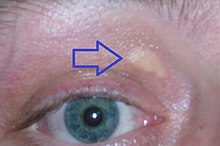| Dyslipidemia | |
|---|---|
 | |
| Yellowish patch consisting of cholesterol above the eyelids. These are more common in people with familial hypercholesterolemia. | |
| Specialty | Cardiology |
| Symptoms | None, yellowish lipid deposits in the skin [1] [2] |
| Complications | Heart disease, stroke, pancreatitis [1] [2] |
| Types | Phenotype I, IIa, IIb, III, IV, V [1] |
| Risk factors | Genetics, poor diet, inactivity, obesity, smoking, diabetes, nephrotic syndrome, biliary obstruction, hypothyroidism, certain medications [1] [2] |
| Diagnostic method | Blood tests for total, LDL, and HDL cholesterol, and triglycerides [1] |
| Treatment | Lifestyle changes, medications [1] |
| Frequency | Common [1] |
Dyslipidemia is an abnormal amount of lipids (fats) in the blood. [1] It is divided into six types which result in some combination of high total cholesterol, high LDL cholesterol, low HDL cholesterol, high triglycerides, or high apolipoprotein B. [1] There are generally no symptoms, though occasionally yellowish lipid deposits within the skin occur. [1] [2] Complications may include heart disease, stroke, and pancreatitis. [1] [2]
Causes may include poor diet, inactivity, obesity, excessive alcohol, and smoking. [1] [2] Other health conditions that can result in dyslipiedmia include diabetes, nephrotic syndrome, biliary obstruction, hypothyroidism, and certain medications. [1] [2] Some types run in families such as familial hypercholesterolemia. [1] Diagnosis is generally by blood tests for total, LDL, and HDL cholesterol, and triglycerides. [1]
Treatment involves lifestyle changes including a diet high in vegetables and exercise. [1] Other treatments depend in part on the types of dyslipidemia. [2] If medications are used, the initial choice is generally a statin. [1] Dyslipidemia becomes more common with age. [1] In the United States high cholesterol affects about 34% of those over the age of 20. [1]
References
- ^
a
b
c
d
e
f
g
h
i
j
k
l
m
n
o
p
q
r
s Pappan, N; Rehman, A (January 2020). "Dyslipidemia".
PMID
32809726.
{{ cite journal}}: Cite journal requires|journal=( help) - ^ a b c d e f g h "Dyslipidemia - Endocrine and Metabolic Disorders". Merck Manuals Professional Edition. Archived from the original on 19 November 2020. Retrieved 20 November 2020.
| Dyslipidemia | |
|---|---|
 | |
| Yellowish patch consisting of cholesterol above the eyelids. These are more common in people with familial hypercholesterolemia. | |
| Specialty | Cardiology |
| Symptoms | None, yellowish lipid deposits in the skin [1] [2] |
| Complications | Heart disease, stroke, pancreatitis [1] [2] |
| Types | Phenotype I, IIa, IIb, III, IV, V [1] |
| Risk factors | Genetics, poor diet, inactivity, obesity, smoking, diabetes, nephrotic syndrome, biliary obstruction, hypothyroidism, certain medications [1] [2] |
| Diagnostic method | Blood tests for total, LDL, and HDL cholesterol, and triglycerides [1] |
| Treatment | Lifestyle changes, medications [1] |
| Frequency | Common [1] |
Dyslipidemia is an abnormal amount of lipids (fats) in the blood. [1] It is divided into six types which result in some combination of high total cholesterol, high LDL cholesterol, low HDL cholesterol, high triglycerides, or high apolipoprotein B. [1] There are generally no symptoms, though occasionally yellowish lipid deposits within the skin occur. [1] [2] Complications may include heart disease, stroke, and pancreatitis. [1] [2]
Causes may include poor diet, inactivity, obesity, excessive alcohol, and smoking. [1] [2] Other health conditions that can result in dyslipiedmia include diabetes, nephrotic syndrome, biliary obstruction, hypothyroidism, and certain medications. [1] [2] Some types run in families such as familial hypercholesterolemia. [1] Diagnosis is generally by blood tests for total, LDL, and HDL cholesterol, and triglycerides. [1]
Treatment involves lifestyle changes including a diet high in vegetables and exercise. [1] Other treatments depend in part on the types of dyslipidemia. [2] If medications are used, the initial choice is generally a statin. [1] Dyslipidemia becomes more common with age. [1] In the United States high cholesterol affects about 34% of those over the age of 20. [1]
References
- ^
a
b
c
d
e
f
g
h
i
j
k
l
m
n
o
p
q
r
s Pappan, N; Rehman, A (January 2020). "Dyslipidemia".
PMID
32809726.
{{ cite journal}}: Cite journal requires|journal=( help) - ^ a b c d e f g h "Dyslipidemia - Endocrine and Metabolic Disorders". Merck Manuals Professional Edition. Archived from the original on 19 November 2020. Retrieved 20 November 2020.